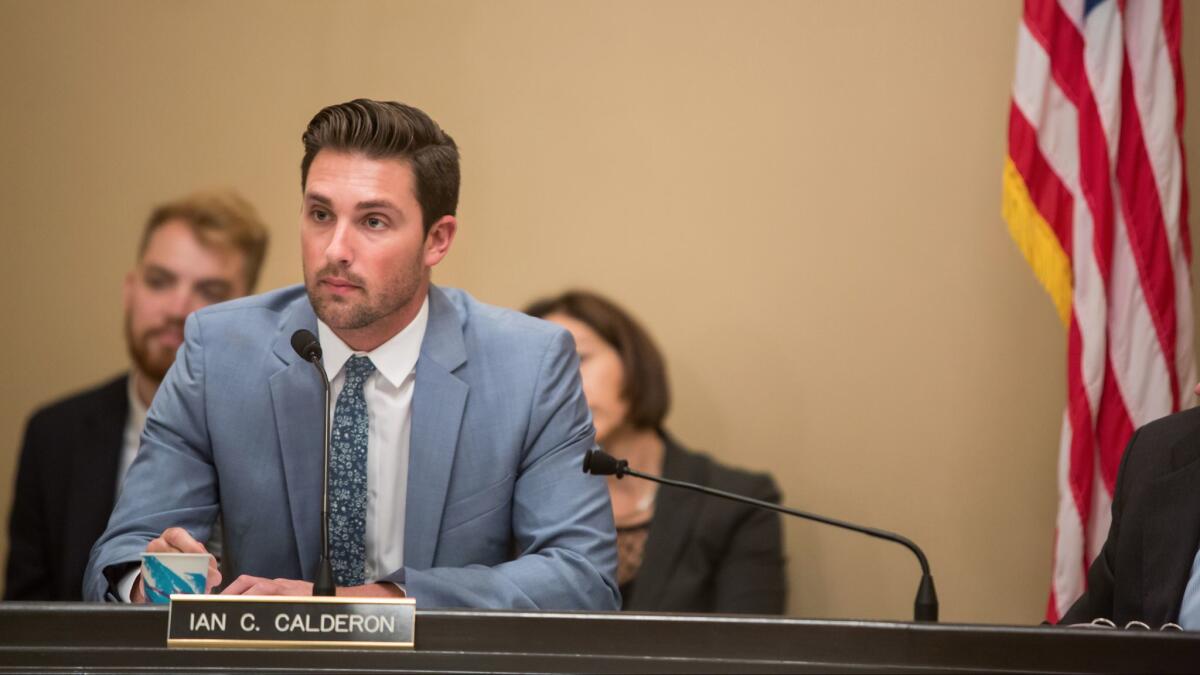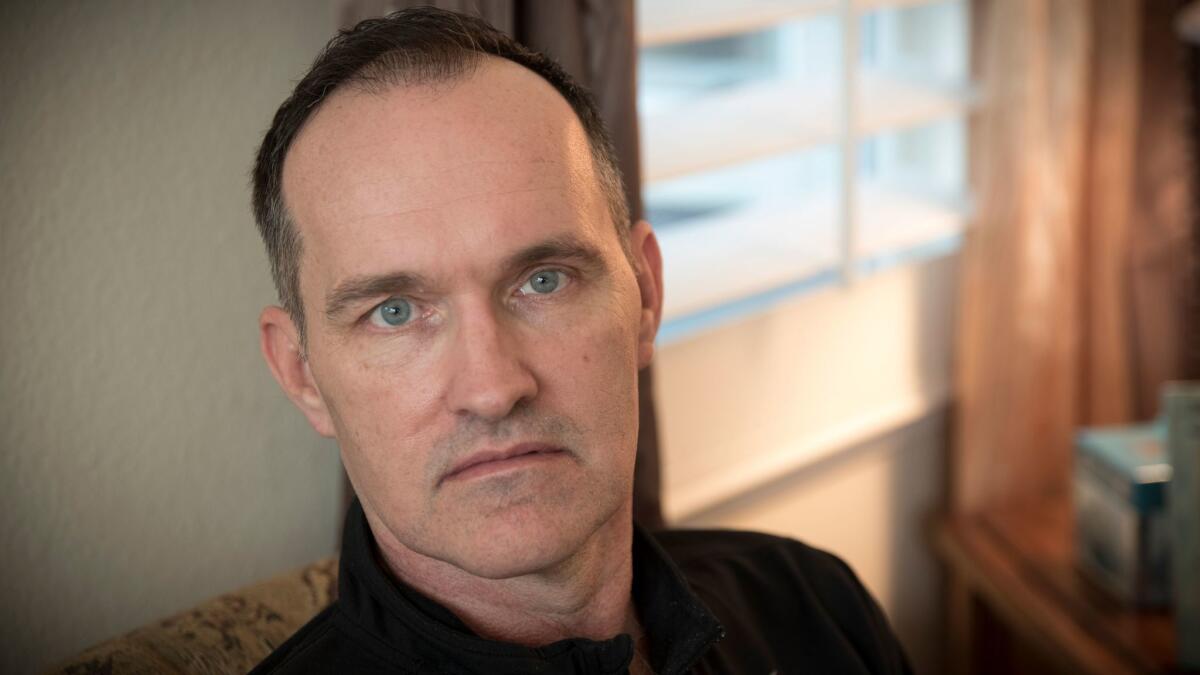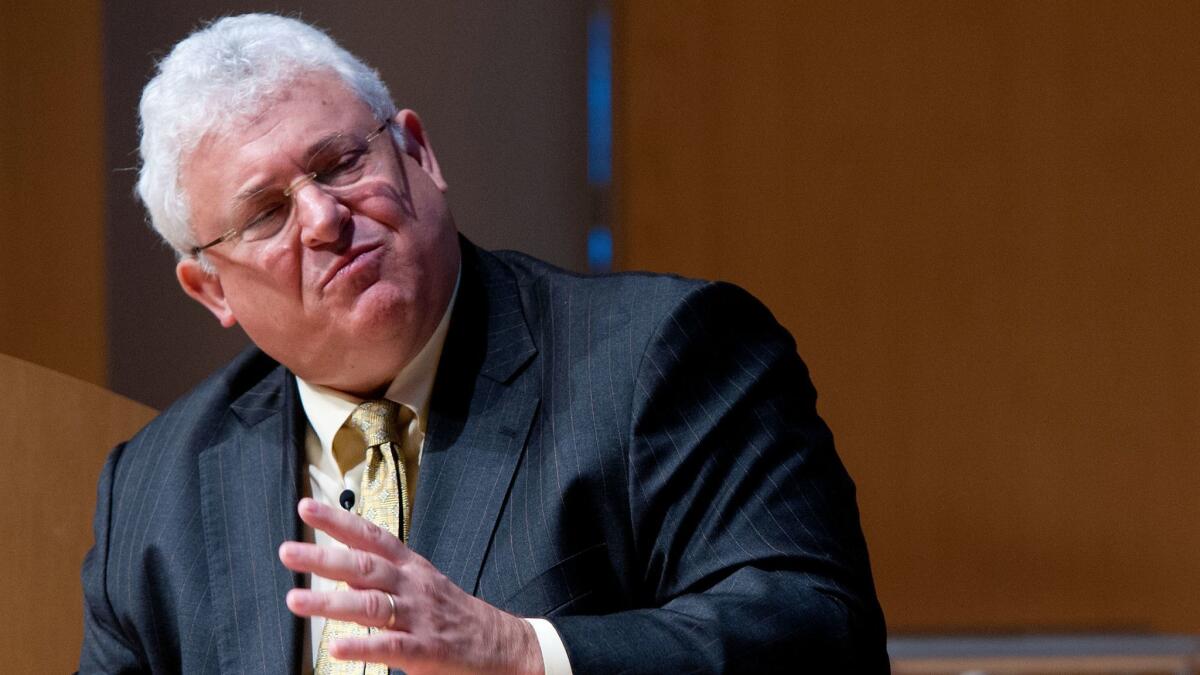Dying patients want easier access to experimental drugs. Here’s why experts say that’s bad medicine
- Share via
Former firefighter Mike DeBartoli is a man desperate to rescue himself. He suffers from amyotrophic lateral sclerosis, the degenerative nerve disorder better known as Lou Gehrig’s disease, which usually kills within five years. He has already spent one year in a clinical trial, taking four pills a day that may have been a placebo. It didn’t help.
DeBartoli walks with difficulty and falls frequently. He’s losing his ability to breathe on his own. Now the 55-year-old from Tracy, Calif., has pinned his hopes on an experimental drug made by Genentech — and a new “right-to-try” law that allows desperate patients to take medications before they’ve been fully vetted by the Food and Drug Administration.
At a time when agreement on any subject seems impossible, the movement to give sick people more access to potentially lifesaving drugs is a rarity. Right-to-try laws have been adopted in 33 states and are under consideration in the remaining 17, with support from across the political spectrum.
The measure’s newest fan is President Trump, who said the FDA’s caution in granting dying patients access to some medications has “always disturbed” him.
But for all its populist appeal, the push for right-to-try laws has raised the ire of ethicists, drug-safety experts and a former FDA commissioner. They say the laws do virtually nothing to expand patients’ access to effective drugs.
DeBartoli doesn’t see it that way. Since California’s law went into effect on Jan. 1, all he needs to get his hands on Genentech’s GDC-0134 is the company’s cooperation and the backing of two physicians.
Assembly Majority Leader Ian Calderon, who sponsored the measure, said it had bipartisan backing in Sacramento because the FDA’s program “was cumbersome, and you had a lot of paperwork to fill out. It really wasn’t respectful of the time that a lot of patients had.”

It really wasn’t respectful of the time that a lot of patients had.
— California Assembly Majority Leader Ian Calderon, on the FDA’s compassionate-use program
Critics counter that the state measures undermine an FDA program that balances patients’ need for options, drug companies’ desire to protect their investments, and the government’s duty to evaluate drug safety and effectiveness.
The FDA’s “compassionate-use” program could be improved, said Dr. Andrew von Eschenbach, who led the agency from 2006 to 2009. But the right-to-try laws don’t do that.
A federal version could also pave the way for controversial FDA reforms to speed drug approvals by relaxing some requirements. Dr. Scott Gottlieb, Trump’s nominee to lead the agency, has said he would favor a faster vetting process.
“We’re going to be changing a lot of the rules,” Trump told drug makers who visited the White House.
Under the right-to-try measures, a dying patient can seek access to an experimental drug if it is an active candidate for FDA approval and has successfully passed a Phase 1 clinical trial to explore its safety, at various doses, in healthy human volunteers.
That standard falls well short of proof that a drug will work, or that it won’t have side effects that could harm a patient or increase the discomfort of his or her final days.
Drug makers are under no obligation to provide experimental medication.

You gotta try something.
— Mike DeBartoli, who hopes California’s new “right-to-try” law will help him get access to life-saving medicine.
Right-to-try laws offer patients an alternative to the compassionate use, or expanded access, program the FDA has had in place for more than two decades. As many as 1,821 applications are filed each year, and about 99% of them are approved, according to the agency.
Emergency requests “are usually granted immediately over the phone, and non-emergencies are processed in a median of four days,” Dr. Peter Lurie, associate FDA commissioner, told a Senate committee in September. The application process was streamlined in June, reducing the required documentation from eight attachments to one, which can be completed in 45 minutes, he said.
But right-to-try supporters complain the process takes too long and is too restrictive. More broadly, they say, people should not need to petition a government agency in the first place.
When a patient is fighting for his or her life, “you shouldn’t have to fight your government too,” said Starlee Coleman of the libertarian Goldwater Institute, who drafted the model right-to-try legislation for states.
“This is the most fundamental liberty we have: the right to save your own life,” she added.
Vice President Mike Pence, who signed a right-to-try bill as governor of Indiana, recently said he expected to have a federal measure on Trump’s desk soon.
That bill, as currently written, differs from the FDA program in important ways.
Among them: It forbids the FDA from considering the experiences of right-to-try patients when deciding whether to approve experimental drugs. Currently, the agency can halt ongoing clinical trials or delay approval if a drug hastens a patient’s death or causes serious side effects.
That makes it all but impossible for drug makers to grant requests from patients such as DeBartoli, Coleman said. The predictable death of a compassionate-use patient would jeopardize a company’s multimillion-dollar investment, she said.
Lurie disputed this. When deaths occur, the FDA takes a patient’s dire state into account, he said.
In more than 11,000 compassionate-use cases over the last decade, patient deaths have halted a drug’s progress only twice, he said. Both times the medications got back on track after a brief delay.

If you close the FDA’s expanded access program, the idea that desperate people might be getting drugs the next morning — it’s just not true.
— Bioethicist Arthur Caplan
The real reason companies aren’t eager to provide experimental drugs is that they “don’t want to get involved,” said New York University bioethicist Arthur Caplan. That problem won’t be fixed by right-to-try laws, he added.
Pharmaceutical companies are set up to get their products through the FDA’s rigorous approval process, not to get drugs to patients ahead of FDA approval, Caplan said. Many wouldn’t know what dose to recommend, let alone how they’d distribute them or how much they should charge. And for unscrupulous companies, the measure’s “completely vague” language on what drug makers can charge provides an opening to fleece desperate patients, he added.
Moreover, most companies have limited quantities of these drugs on hand and no policies to allocate them among all who want them, Caplan said.
Finally, when a patient dies or suffers adverse effects from an experimental medication, companies are much less afraid of the FDA finding out than they are of investors getting wind of the setback.
Caplan knows this because in 2015, he and his colleagues at NYU’s Langone Medical Center were asked by Janssen Biotech Inc. to create a model of a “compassionate use advisory committee” for a multiple myeloma drug called daratumumab. It was the first-ever effort of its kind, which underscores how poorly prepared drug companies are to handle right-to-try requests. (Daratumumab was approved in November and is now marketed as Darzalex.)
Caplan calls the right-to-try measures “feel-good” laws that don’t address the shortcomings of the FDA’s program but undo its benefits.
“If you close the FDA’s expanded access program, the idea that desperate people might be getting drugs the next morning — it’s just not true,” he said.
Nor is it true that greater access to experimental drugs will do much to help patients such as DeBartoli, said Dr. Adams Dudley, who directs UC San Francisco’s Center for Healthcare Value. The numbers just don’t add up.

There isn’t some vast pool of drugs that, if only the FDA would get out of the way and let patients at them, would help them.
— Dr. Adams Dudley, director of UC San Francisco’s Center for Healthcare Value
Almost two-thirds of drugs that enter clinical trials make it out of the first stage of safety testing and are eligible for right-to-try requests. But few are ultimately helpful, Dudley said.
Among 108 drug candidates abandoned after a Phase 2 clinical trial — where safety and preliminary effectiveness are explored — 20% failed because they were unsafe for sick patients and just over half were dropped because they seemed ineffective, according to a 2011 study.
More drugs failed in Phase 3 trials, where effectiveness is rigorously tested. At this stage, 21% missed the cut because of safety issues and two-thirds were abandoned because they didn’t seem to work.
“There isn’t some vast pool of drugs that, if only the FDA would get out of the way and let patients at them, would help them,” Dudley said.
“There are patients who are passionate about it, and there’s no way not to feel sympathetic toward them,” he added. But “doctors and nurses know that side effects can be horrible, making a peaceful death impossible. They think of it as pretty much a false hope.”
DeBartoli said he’d rather have false hope than no hope at all.
“You gotta try something,” he said.
Follow me on Twitter @LATMelissaHealy and “like” Los Angeles Times Science & Health on Facebook.
MORE IN SCIENCE
As obesity keeps rising, more Americans are just giving up
Pregnant women with Zika are 20 times more likely to have a baby with a birth defect, CDC says




